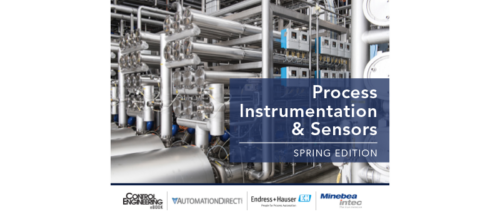Reviewing flow sensors, flow sensor technology
New 180 Series OEM flow sensors from Fluid Components International offer accuracy, fast response, and reliability.
New 180 Series OEM flow sensors from Fluid Components International use thermal dispersion technology.
New 180 Series OEM flow sensors from Fluid Components International offer accuracy, fast response, and reliability. Using thermal dispersion sensor technology to fit a wide range of OEM applications, the devices are designed for use in equipment or machinery that requires flow or level sensing as part of its control system loop or as part of its operating system. Flow sensors provide switching, alarming, rate metering and totalizing of air, gases or liquids. They are suited for fuel and air feed lines, additive dispensing control, oil and lubricant circulation, pump protection circuits, cooling system controls, and more. Devices support line sizes from 0.25 to 6 in.
More on flow sensor technology : Flow sensors play an important role in many applications. Here’s some additional information on flow sensor technology and the 180 Series flow sensor , including how it is applied and how it works.
The efficient operation of equipment in modern materials processing and discrete manufacturing plants often depends on the accurate flow sensing measurement of gases, liquids and slurries. Accurate air flow measurement, for example, in OEM equipment such as boilers and burners is not only critical to achieving the necessary temperatures for operation, but also to operate as efficiently as possible and reduce energy consumption, pollution and cost. Typical applications Air Compressors. Many manufacturing plants depend on compressed air for aeration mixing and powering pneumatic equipment in assembly processes. Thermal flow sensors embedded within a process control loop, at main distribution points and point-of-use help ensure the compressors provide only the necessary and optimum amount of air and trap leaks. These sensors provide a highly reliable and consistent airflow and minimize energy costs.
Gas Compressors. In food processing plants, where liquid nitrogen is used in cooling systems, thermal sensors measure nitrogen flow to ensure the right amount of gas is used to ensure process quality. Similar applications for flow sensors are found in large commercial ammonia refrigeration systems. In both applications, wide turndown ratios (100:1), low flow sensitivity and negligible pressure drop, make thermal flow sensors a good solution.
Pump Protection Circuits. Pumps are expensive and can be maintenance intensive if they are allowed to run dry, causing excessive wear to the pump components. Thermal flow sensors added in a control loop or alarm system help ensure that pumps never run dry and that they achieve a graceful shutdown should the process media stop flowing. Sealed design eliminates all contact with the process media to prevent contamination. No-clog sensor heads makes the flow sensors suitable for use in liquids and slurries.
Additive Dispensing Control. In pharmaceuticals processing, highly accurate thermal flow sensors within pumps support liquid additive dispensing. Precise measurement of additive flow helps ensure batch control quality essential in the pharmaceuticals industry. Designed to support line sizes down to 0.25 in. (6 mm), these flow sensors are also suitable for prototyping and laboratory applications as well. Thermal flow sensing Thermal dispersion flow sensors offer accuracy, repeatability, and rugged construction, for reliability, long life, and low maintenance. Simple to install, they offer low total cost and long life-cycle solutions for embedded OEM equipment flow-sensor applications. No-moving-parts design limits clogging and breakage requiring maintenance and replacement.
The thermal flow-sensing element contains two thermowell-protected resistance temperature detectors (platinum RTDs). One RTD is heated and the other senses the gas or fluid temperature. The temperature difference between the two relates to the fluid flow rate. RTDs provide a true mass flow analog output (without pressure or temperature transducers), as well as temperature, totalizing and alarm outputs. The result is high accuracy, noncontact sensing. Simple to install, they are minimally invasive to yield reduced pressure-drop as well.
—Jeanine Katzel, senior editor, Control Engineering, jkatzel@reedbusiness.com
Do you have experience and expertise with the topics mentioned in this content? You should consider contributing to our CFE Media editorial team and getting the recognition you and your company deserve. Click here to start this process.


